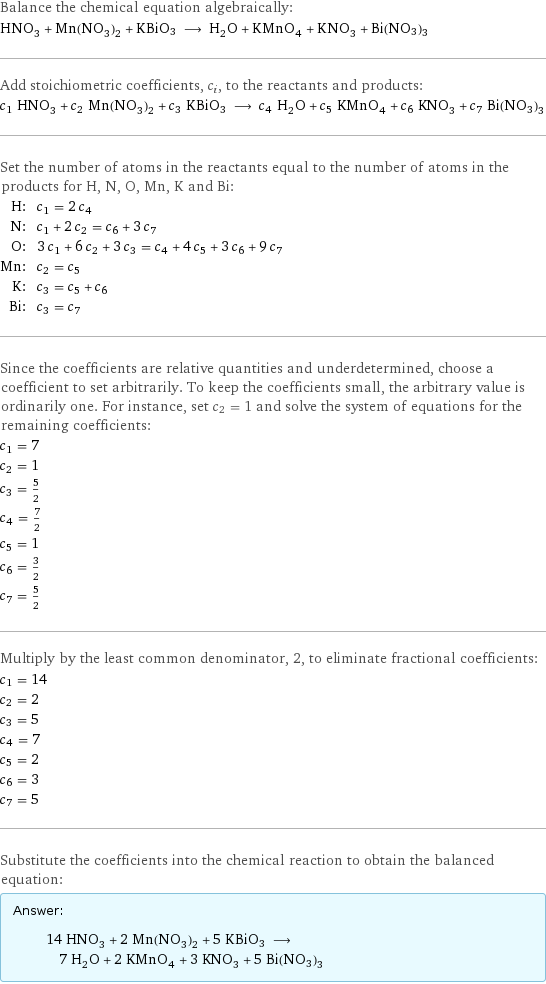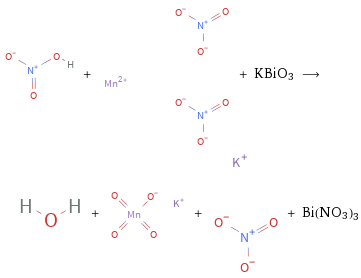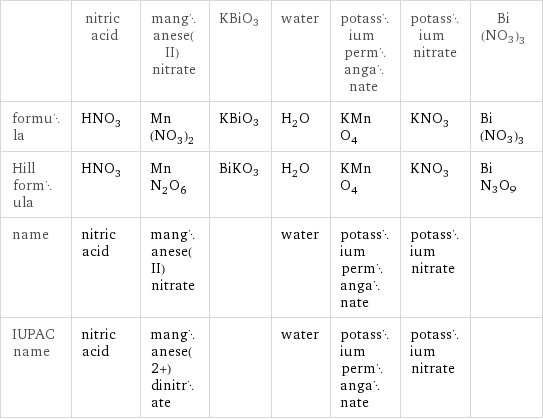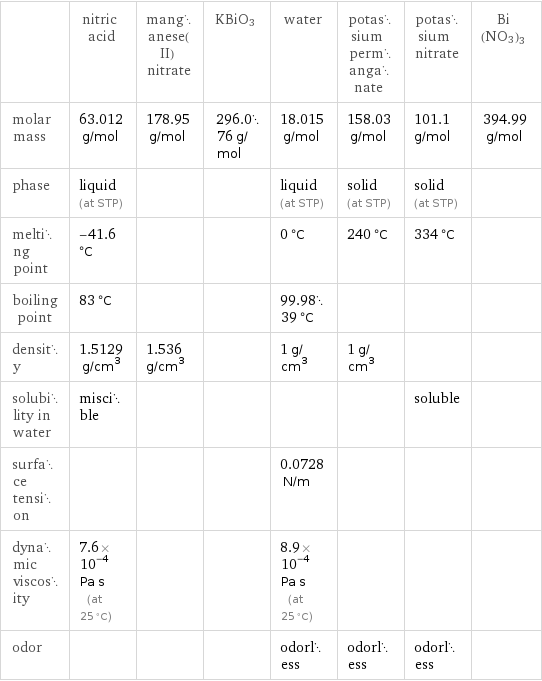Input interpretation

HNO_3 nitric acid + Mn(NO_3)_2 manganese(II) nitrate + KBiO3 ⟶ H_2O water + KMnO_4 potassium permanganate + KNO_3 potassium nitrate + Bi(NO3)3
Balanced equation

Balance the chemical equation algebraically: HNO_3 + Mn(NO_3)_2 + KBiO3 ⟶ H_2O + KMnO_4 + KNO_3 + Bi(NO3)3 Add stoichiometric coefficients, c_i, to the reactants and products: c_1 HNO_3 + c_2 Mn(NO_3)_2 + c_3 KBiO3 ⟶ c_4 H_2O + c_5 KMnO_4 + c_6 KNO_3 + c_7 Bi(NO3)3 Set the number of atoms in the reactants equal to the number of atoms in the products for H, N, O, Mn, K and Bi: H: | c_1 = 2 c_4 N: | c_1 + 2 c_2 = c_6 + 3 c_7 O: | 3 c_1 + 6 c_2 + 3 c_3 = c_4 + 4 c_5 + 3 c_6 + 9 c_7 Mn: | c_2 = c_5 K: | c_3 = c_5 + c_6 Bi: | c_3 = c_7 Since the coefficients are relative quantities and underdetermined, choose a coefficient to set arbitrarily. To keep the coefficients small, the arbitrary value is ordinarily one. For instance, set c_2 = 1 and solve the system of equations for the remaining coefficients: c_1 = 7 c_2 = 1 c_3 = 5/2 c_4 = 7/2 c_5 = 1 c_6 = 3/2 c_7 = 5/2 Multiply by the least common denominator, 2, to eliminate fractional coefficients: c_1 = 14 c_2 = 2 c_3 = 5 c_4 = 7 c_5 = 2 c_6 = 3 c_7 = 5 Substitute the coefficients into the chemical reaction to obtain the balanced equation: Answer: | | 14 HNO_3 + 2 Mn(NO_3)_2 + 5 KBiO3 ⟶ 7 H_2O + 2 KMnO_4 + 3 KNO_3 + 5 Bi(NO3)3
Structures

+ + KBiO3 ⟶ + + + Bi(NO3)3
Names

nitric acid + manganese(II) nitrate + KBiO3 ⟶ water + potassium permanganate + potassium nitrate + Bi(NO3)3
Equilibrium constant
![Construct the equilibrium constant, K, expression for: HNO_3 + Mn(NO_3)_2 + KBiO3 ⟶ H_2O + KMnO_4 + KNO_3 + Bi(NO3)3 Plan: • Balance the chemical equation. • Determine the stoichiometric numbers. • Assemble the activity expression for each chemical species. • Use the activity expressions to build the equilibrium constant expression. Write the balanced chemical equation: 14 HNO_3 + 2 Mn(NO_3)_2 + 5 KBiO3 ⟶ 7 H_2O + 2 KMnO_4 + 3 KNO_3 + 5 Bi(NO3)3 Assign stoichiometric numbers, ν_i, using the stoichiometric coefficients, c_i, from the balanced chemical equation in the following manner: ν_i = -c_i for reactants and ν_i = c_i for products: chemical species | c_i | ν_i HNO_3 | 14 | -14 Mn(NO_3)_2 | 2 | -2 KBiO3 | 5 | -5 H_2O | 7 | 7 KMnO_4 | 2 | 2 KNO_3 | 3 | 3 Bi(NO3)3 | 5 | 5 Assemble the activity expressions accounting for the state of matter and ν_i: chemical species | c_i | ν_i | activity expression HNO_3 | 14 | -14 | ([HNO3])^(-14) Mn(NO_3)_2 | 2 | -2 | ([Mn(NO3)2])^(-2) KBiO3 | 5 | -5 | ([KBiO3])^(-5) H_2O | 7 | 7 | ([H2O])^7 KMnO_4 | 2 | 2 | ([KMnO4])^2 KNO_3 | 3 | 3 | ([KNO3])^3 Bi(NO3)3 | 5 | 5 | ([Bi(NO3)3])^5 The equilibrium constant symbol in the concentration basis is: K_c Mulitply the activity expressions to arrive at the K_c expression: Answer: | | K_c = ([HNO3])^(-14) ([Mn(NO3)2])^(-2) ([KBiO3])^(-5) ([H2O])^7 ([KMnO4])^2 ([KNO3])^3 ([Bi(NO3)3])^5 = (([H2O])^7 ([KMnO4])^2 ([KNO3])^3 ([Bi(NO3)3])^5)/(([HNO3])^14 ([Mn(NO3)2])^2 ([KBiO3])^5)](../image_source/baad4b9dc58010e8cc17d2aadbc51068.png)
Construct the equilibrium constant, K, expression for: HNO_3 + Mn(NO_3)_2 + KBiO3 ⟶ H_2O + KMnO_4 + KNO_3 + Bi(NO3)3 Plan: • Balance the chemical equation. • Determine the stoichiometric numbers. • Assemble the activity expression for each chemical species. • Use the activity expressions to build the equilibrium constant expression. Write the balanced chemical equation: 14 HNO_3 + 2 Mn(NO_3)_2 + 5 KBiO3 ⟶ 7 H_2O + 2 KMnO_4 + 3 KNO_3 + 5 Bi(NO3)3 Assign stoichiometric numbers, ν_i, using the stoichiometric coefficients, c_i, from the balanced chemical equation in the following manner: ν_i = -c_i for reactants and ν_i = c_i for products: chemical species | c_i | ν_i HNO_3 | 14 | -14 Mn(NO_3)_2 | 2 | -2 KBiO3 | 5 | -5 H_2O | 7 | 7 KMnO_4 | 2 | 2 KNO_3 | 3 | 3 Bi(NO3)3 | 5 | 5 Assemble the activity expressions accounting for the state of matter and ν_i: chemical species | c_i | ν_i | activity expression HNO_3 | 14 | -14 | ([HNO3])^(-14) Mn(NO_3)_2 | 2 | -2 | ([Mn(NO3)2])^(-2) KBiO3 | 5 | -5 | ([KBiO3])^(-5) H_2O | 7 | 7 | ([H2O])^7 KMnO_4 | 2 | 2 | ([KMnO4])^2 KNO_3 | 3 | 3 | ([KNO3])^3 Bi(NO3)3 | 5 | 5 | ([Bi(NO3)3])^5 The equilibrium constant symbol in the concentration basis is: K_c Mulitply the activity expressions to arrive at the K_c expression: Answer: | | K_c = ([HNO3])^(-14) ([Mn(NO3)2])^(-2) ([KBiO3])^(-5) ([H2O])^7 ([KMnO4])^2 ([KNO3])^3 ([Bi(NO3)3])^5 = (([H2O])^7 ([KMnO4])^2 ([KNO3])^3 ([Bi(NO3)3])^5)/(([HNO3])^14 ([Mn(NO3)2])^2 ([KBiO3])^5)
Rate of reaction
![Construct the rate of reaction expression for: HNO_3 + Mn(NO_3)_2 + KBiO3 ⟶ H_2O + KMnO_4 + KNO_3 + Bi(NO3)3 Plan: • Balance the chemical equation. • Determine the stoichiometric numbers. • Assemble the rate term for each chemical species. • Write the rate of reaction expression. Write the balanced chemical equation: 14 HNO_3 + 2 Mn(NO_3)_2 + 5 KBiO3 ⟶ 7 H_2O + 2 KMnO_4 + 3 KNO_3 + 5 Bi(NO3)3 Assign stoichiometric numbers, ν_i, using the stoichiometric coefficients, c_i, from the balanced chemical equation in the following manner: ν_i = -c_i for reactants and ν_i = c_i for products: chemical species | c_i | ν_i HNO_3 | 14 | -14 Mn(NO_3)_2 | 2 | -2 KBiO3 | 5 | -5 H_2O | 7 | 7 KMnO_4 | 2 | 2 KNO_3 | 3 | 3 Bi(NO3)3 | 5 | 5 The rate term for each chemical species, B_i, is 1/ν_i(Δ[B_i])/(Δt) where [B_i] is the amount concentration and t is time: chemical species | c_i | ν_i | rate term HNO_3 | 14 | -14 | -1/14 (Δ[HNO3])/(Δt) Mn(NO_3)_2 | 2 | -2 | -1/2 (Δ[Mn(NO3)2])/(Δt) KBiO3 | 5 | -5 | -1/5 (Δ[KBiO3])/(Δt) H_2O | 7 | 7 | 1/7 (Δ[H2O])/(Δt) KMnO_4 | 2 | 2 | 1/2 (Δ[KMnO4])/(Δt) KNO_3 | 3 | 3 | 1/3 (Δ[KNO3])/(Δt) Bi(NO3)3 | 5 | 5 | 1/5 (Δ[Bi(NO3)3])/(Δt) (for infinitesimal rate of change, replace Δ with d) Set the rate terms equal to each other to arrive at the rate expression: Answer: | | rate = -1/14 (Δ[HNO3])/(Δt) = -1/2 (Δ[Mn(NO3)2])/(Δt) = -1/5 (Δ[KBiO3])/(Δt) = 1/7 (Δ[H2O])/(Δt) = 1/2 (Δ[KMnO4])/(Δt) = 1/3 (Δ[KNO3])/(Δt) = 1/5 (Δ[Bi(NO3)3])/(Δt) (assuming constant volume and no accumulation of intermediates or side products)](../image_source/1d05d8c9fa421c8664e70fc1934ba380.png)
Construct the rate of reaction expression for: HNO_3 + Mn(NO_3)_2 + KBiO3 ⟶ H_2O + KMnO_4 + KNO_3 + Bi(NO3)3 Plan: • Balance the chemical equation. • Determine the stoichiometric numbers. • Assemble the rate term for each chemical species. • Write the rate of reaction expression. Write the balanced chemical equation: 14 HNO_3 + 2 Mn(NO_3)_2 + 5 KBiO3 ⟶ 7 H_2O + 2 KMnO_4 + 3 KNO_3 + 5 Bi(NO3)3 Assign stoichiometric numbers, ν_i, using the stoichiometric coefficients, c_i, from the balanced chemical equation in the following manner: ν_i = -c_i for reactants and ν_i = c_i for products: chemical species | c_i | ν_i HNO_3 | 14 | -14 Mn(NO_3)_2 | 2 | -2 KBiO3 | 5 | -5 H_2O | 7 | 7 KMnO_4 | 2 | 2 KNO_3 | 3 | 3 Bi(NO3)3 | 5 | 5 The rate term for each chemical species, B_i, is 1/ν_i(Δ[B_i])/(Δt) where [B_i] is the amount concentration and t is time: chemical species | c_i | ν_i | rate term HNO_3 | 14 | -14 | -1/14 (Δ[HNO3])/(Δt) Mn(NO_3)_2 | 2 | -2 | -1/2 (Δ[Mn(NO3)2])/(Δt) KBiO3 | 5 | -5 | -1/5 (Δ[KBiO3])/(Δt) H_2O | 7 | 7 | 1/7 (Δ[H2O])/(Δt) KMnO_4 | 2 | 2 | 1/2 (Δ[KMnO4])/(Δt) KNO_3 | 3 | 3 | 1/3 (Δ[KNO3])/(Δt) Bi(NO3)3 | 5 | 5 | 1/5 (Δ[Bi(NO3)3])/(Δt) (for infinitesimal rate of change, replace Δ with d) Set the rate terms equal to each other to arrive at the rate expression: Answer: | | rate = -1/14 (Δ[HNO3])/(Δt) = -1/2 (Δ[Mn(NO3)2])/(Δt) = -1/5 (Δ[KBiO3])/(Δt) = 1/7 (Δ[H2O])/(Δt) = 1/2 (Δ[KMnO4])/(Δt) = 1/3 (Δ[KNO3])/(Δt) = 1/5 (Δ[Bi(NO3)3])/(Δt) (assuming constant volume and no accumulation of intermediates or side products)
Chemical names and formulas

| nitric acid | manganese(II) nitrate | KBiO3 | water | potassium permanganate | potassium nitrate | Bi(NO3)3 formula | HNO_3 | Mn(NO_3)_2 | KBiO3 | H_2O | KMnO_4 | KNO_3 | Bi(NO3)3 Hill formula | HNO_3 | MnN_2O_6 | BiKO3 | H_2O | KMnO_4 | KNO_3 | BiN3O9 name | nitric acid | manganese(II) nitrate | | water | potassium permanganate | potassium nitrate | IUPAC name | nitric acid | manganese(2+) dinitrate | | water | potassium permanganate | potassium nitrate |
Substance properties

| nitric acid | manganese(II) nitrate | KBiO3 | water | potassium permanganate | potassium nitrate | Bi(NO3)3 molar mass | 63.012 g/mol | 178.95 g/mol | 296.076 g/mol | 18.015 g/mol | 158.03 g/mol | 101.1 g/mol | 394.99 g/mol phase | liquid (at STP) | | | liquid (at STP) | solid (at STP) | solid (at STP) | melting point | -41.6 °C | | | 0 °C | 240 °C | 334 °C | boiling point | 83 °C | | | 99.9839 °C | | | density | 1.5129 g/cm^3 | 1.536 g/cm^3 | | 1 g/cm^3 | 1 g/cm^3 | | solubility in water | miscible | | | | | soluble | surface tension | | | | 0.0728 N/m | | | dynamic viscosity | 7.6×10^-4 Pa s (at 25 °C) | | | 8.9×10^-4 Pa s (at 25 °C) | | | odor | | | | odorless | odorless | odorless |
Units
